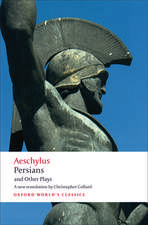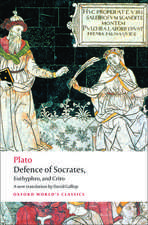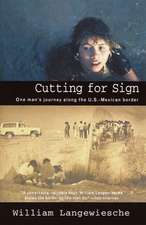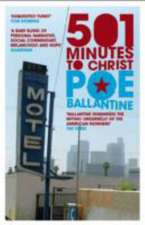Aloft: Penguin Modern Classics
Autor William Langewiescheen Limba Engleză Paperback – 24 feb 2010
Full of spare and elegant prose,Aloftis a fascinating journey into the new, profound dimension that flight has added to the human experience.
| Toate formatele și edițiile | Preț | Express |
|---|---|---|
| Paperback (2) | 81.65 lei 6-8 săpt. | |
| Vintage Books USA – 30 sep 2010 | 99.41 lei 3-5 săpt. | |
| Penguin Books – 24 feb 2010 | 81.65 lei 6-8 săpt. |
Din seria Penguin Modern Classics
- 17%
 Preț: 41.41 lei
Preț: 41.41 lei -
 Preț: 82.90 lei
Preț: 82.90 lei -
 Preț: 80.98 lei
Preț: 80.98 lei - 15%
 Preț: 48.87 lei
Preț: 48.87 lei - 17%
 Preț: 52.07 lei
Preț: 52.07 lei - 19%
 Preț: 59.39 lei
Preț: 59.39 lei - 18%
 Preț: 46.05 lei
Preț: 46.05 lei - 17%
 Preț: 52.49 lei
Preț: 52.49 lei -
 Preț: 69.06 lei
Preț: 69.06 lei - 16%
 Preț: 58.66 lei
Preț: 58.66 lei - 17%
 Preț: 51.67 lei
Preț: 51.67 lei -
 Preț: 81.84 lei
Preț: 81.84 lei - 18%
 Preț: 46.25 lei
Preț: 46.25 lei -
 Preț: 97.20 lei
Preț: 97.20 lei - 17%
 Preț: 52.33 lei
Preț: 52.33 lei - 15%
 Preț: 48.90 lei
Preț: 48.90 lei - 16%
 Preț: 53.55 lei
Preț: 53.55 lei - 18%
 Preț: 51.39 lei
Preț: 51.39 lei -
 Preț: 63.28 lei
Preț: 63.28 lei - 16%
 Preț: 53.93 lei
Preț: 53.93 lei - 18%
 Preț: 51.00 lei
Preț: 51.00 lei - 15%
 Preț: 49.40 lei
Preț: 49.40 lei - 15%
 Preț: 55.26 lei
Preț: 55.26 lei - 16%
 Preț: 48.30 lei
Preț: 48.30 lei - 17%
 Preț: 52.10 lei
Preț: 52.10 lei -
 Preț: 81.61 lei
Preț: 81.61 lei - 17%
 Preț: 68.49 lei
Preț: 68.49 lei - 18%
 Preț: 46.25 lei
Preț: 46.25 lei - 18%
 Preț: 46.02 lei
Preț: 46.02 lei - 16%
 Preț: 42.26 lei
Preț: 42.26 lei - 17%
 Preț: 51.66 lei
Preț: 51.66 lei - 16%
 Preț: 48.45 lei
Preț: 48.45 lei - 16%
 Preț: 42.69 lei
Preț: 42.69 lei - 15%
 Preț: 54.63 lei
Preț: 54.63 lei - 18%
 Preț: 46.31 lei
Preț: 46.31 lei - 18%
 Preț: 46.31 lei
Preț: 46.31 lei - 16%
 Preț: 53.59 lei
Preț: 53.59 lei - 16%
 Preț: 53.11 lei
Preț: 53.11 lei -
 Preț: 95.04 lei
Preț: 95.04 lei - 16%
 Preț: 79.93 lei
Preț: 79.93 lei - 18%
 Preț: 46.02 lei
Preț: 46.02 lei - 16%
 Preț: 68.94 lei
Preț: 68.94 lei -
 Preț: 81.35 lei
Preț: 81.35 lei - 17%
 Preț: 51.60 lei
Preț: 51.60 lei - 18%
 Preț: 51.38 lei
Preț: 51.38 lei - 16%
 Preț: 53.36 lei
Preț: 53.36 lei - 18%
 Preț: 50.73 lei
Preț: 50.73 lei - 16%
 Preț: 48.46 lei
Preț: 48.46 lei - 16%
 Preț: 53.37 lei
Preț: 53.37 lei - 17%
 Preț: 52.33 lei
Preț: 52.33 lei
Preț: 81.65 lei
Nou
Puncte Express: 122
Preț estimativ în valută:
15.62€ • 16.31$ • 12.93£
15.62€ • 16.31$ • 12.93£
Carte tipărită la comandă
Livrare economică 04-18 aprilie
Preluare comenzi: 021 569.72.76
Specificații
ISBN-13: 9780141191850
ISBN-10: 0141191856
Pagini: 272
Dimensiuni: 129 x 198 x 16 mm
Greutate: 0.21 kg
Editura: Penguin Books
Colecția Penguin Classics
Seria Penguin Modern Classics
Locul publicării:London, United Kingdom
ISBN-10: 0141191856
Pagini: 272
Dimensiuni: 129 x 198 x 16 mm
Greutate: 0.21 kg
Editura: Penguin Books
Colecția Penguin Classics
Seria Penguin Modern Classics
Locul publicării:London, United Kingdom
Notă biografică
William
Langewiescheis
an
author
and
journalist.
He
is
currently
Vanity
Fair's
international
correspondent,
having
made
his
name
writing
for
Atlantic
Monthly.
His
strong,
evocative
prose
is
used
to
devastating
effect
on
a
range
of
issues.
Before
embarking
on
a
writing
career
he
worked
as
a
pilot
for
fifteen
years
from
the
age
of
18.
He
has
been
termed
one
of
the
leading
writers
of
The
New
New
Journalism,
a
group
of
writers
who
have
secured
a
place
at
the
centre
of
contemporary
American
literature,
as
Tom
Wolfe
and
The
New
Journalism
did
in
the
sixties.
John Banville'snovels includeThe Book of Evidence,The Sea, andThe Infinities. The Infinitieswill be publlished next month.
John Banville'snovels includeThe Book of Evidence,The Sea, andThe Infinities. The Infinitieswill be publlished next month.
Recenzii
Formidable
talent
...
a
journalist
whose
cool,
precise
and
economical
reporting
is
harnessed
to
an
invigorating
moral
and
intellectual
perspective
Extras
From the First Chapter
The View from Above
After a century of flying, we still live at a moment of emergence like that experienced by creatures first escaping from the sea. For us the emergence has been given meaning because we can think about it, and can perhaps understand the nature of our liberation. Mechanical wings allow us to fly, but it is with our minds that we make the sky ours. The old measures of distance no longer apply, in part because we hop across the globe in single sittings, but also because in doing so we visit a place which even just above our homes is as exotic and revealing as the most foreign destination. This book contains observations of that place, and it takes the form of a spiral climb, occasionally returning overhead of the point where now it begins, with the idea that flight’s gift is to let us look around.
At first I mean a simple form of looking around, and one that requires little instruction – just gazing down at the ordinary scenery sliding by below. The best views are views of familiar things, like cities and farms and bottlenecked freeways. So set aside the beauty of sunsets, the majesty of mountains, the imprint of winds on golden prairies. The world beneath our wings has become a human artifact, our most spontaneous and complex creation. Tourists may not like to contemplate the evidence, with its hints of greed and self-destruction, but the fact remains that the old sterilized landscapes – like designated outlooks and pretty parks and sculpted gardens – have become obsolete, and that it is largely the airplane that has made them so. The aerial view is something entirely new. We need to admit that it flattens the world and mutes it in a rush of air and engines, and that it suppresses beauty. But it also strips the façades from our constructions, and by raising us above the constraints of the treeline and the highway it imposes a brutal honesty on our perceptions. It lets us see ourselves in context, as creatures struggling through life on the face of a planet, not separate from nature, but its most expressive agents. It lets us see that our struggles form patterns on the land, that these patterns repeat to an extent which before we had not known, and that there is a sense to them.
Discovering that sense requires not only that we look outside while fl ying but that we get over the illusion of smallness, the 'Everything looks like a toy!’ that blinds us at fi rst to what we see. I write ‘us’ but frankly mean ‘them’ or ‘you.’ The truth is I can only imagine learning to see from the air, because my father was a pilot with pilot friends, and I grew up inside their airplanes, gazing at the world below. Day after day through the seasons and years we wandered the sky, and I sat looking outside. To pass the time I picked points on the airplane – a strut, a rivet, a place on the leading edge of a wing – and used those points as sighting devices against the ground to measure the airplane’s speed and to define flight’s independent paths across the landscape: for a while along a country lane, but then straight across a field and through someone’s swimming pool, over a factory, into a city and out again. It was quite early in my childhood, as these random paths began to fit together, that I developed a pilot’s integrated sense of the earth’s geometry.
This was in the 1960s, the merest moment after the Wright brothers. When I first flew alone, in a sailplane at the age of fourteen, the experience seemed so normal to me that I have practically no memory of it now. It wasn’t until college, when I took an air-taxi job and began carrying passengers for hire, people unaccustomed to flight, that I realized there was anything unusual about the view. Of course, some passengers did not want to look outside. But others were curious. For me it was like witnessing Stone Age people seeing photographs for the first time, getting used to the scale, then turning with growing excitement from the magic to the content of the picture.
These passengers had ridden on the airlines but had been herded into their cabin seats, distracted by magazines, and given shoulder-height triple-pane windows at right angles to the direction of flight. They had been encouraged not to look outside but rather the opposite – to draw the shades for the movie and pretend not to fly at all. And now suddenly they found themselves in a cockpit wrapped in glass, awash in brilliant light, in a small airplane lingering near the ground.
Some passengers simply could not understand the view. I remember a pristine young woman who, ten miles off the San Francisco coast, looked down from our airplane at a ship plowing through the Pacific swells, then looked up at me and smiled prettily.
I was charmed. I said, ‘What do you think?’
She said, ‘Is this the Napa Valley?’
The airplane was noisy. I said, ‘The what?’
She repeated it, less certainly. ‘The Napa Valley?’
I may have laughed. She looked concerned. Only later did I understand. First flights can confuse the senses and cause normal people to stop thinking.
On another occasion I had a passenger who during a smooth flight at 15,000 feet over Baltimore suspected that perhaps he had died and gone not to heaven but to a suspended place in time. He meant this quite literally. His face turned chalky, as if he were about to faint. I asked him what was wrong.
He stammered his strange uncertainty: Had we by chance been in a mid-air collision back there over Wilmington when the controller warned us about that oncoming airplane which we never spotted? The question put me in the unusual position of having to assure someone that both he and I were indeed still alive.
He was a German art dealer from Berlin and New York, and he did not know Baltimore. The softness of flight had combined with the visible abandonment of the streets below to give him the feeling of death. I explained that it was Super Bowl Sunday and that all Baltimore was watching the game on television. He had been long enough in the United States to understand. The color returned slowly to his skin. I think then that he became interested in the view, which was indeed the view of a sort of afterlife – or of a city in decline.
The German would have felt better over Berlin or New York not because they are healthier cities but because reading the ground from an airplane is easier if you understand some of the local customs. Residents of Baltimore would see their city from the air more clearly than any transient foreigner, and would find the landscape not dormant or deadly, but compelling. Rather than simply knowing about the Super Bowl, they might share with the city below a genuine interest in the game’s outcome – and as result they might not even see a Baltimore in decline. Who could say then whose view was deeper, theirs or mine? But I do know that they would not choose that moment in flight to prefer watching television, because television is dull compared to the view of home from overhead.
I have imagined teaching the aerial view. The best approach would be to apprentice young children as I was apprenticed, to teach them without elaboration simply by flying them to different places, encouraging them to navigate, and to make the translations between maps and the world. Effortlessly they would develop the habit of seeing the world from above, and the more subtle trick while on the ground of understanding the scale and orientation of their surroundings. Flying at its best is a way of thinking. Because of that, once having left the earth’s surface, people never again quite return to it. But also because of that, adults often find it hard to make the leap. They simply have spent too many years on the ground. To teach them the aerial view you would have to overcome that landlubbing prejudice which equates driving on a country road, or sleeping in a hotel and visiting the restaurant part of town, with having ‘been’ somewhere, to the exclusion of other possibilities.
I have a friend, a historian at Princeton University, who upon my return from a low-altitude flight up the Eastern seaboard of the United States denied that I had actually visited the places I had overfl own – the farmed and citied coastal plain from Georgia to New Jersey and in between. I did not invite my friend’s judgment, but he offered it anyway, argumentatively, because he could not shake a certain cramped sense of possession that he had acquired while driving the same route the summer before. He was a jealous sort of traveler, like those who return from tours convinced that theirs is the only authentic experience among the natives of some faraway land. Pilots are generally less-educated types, but they are more charitable about geography. In all my time among them, the endless hours sitting in cockpits and waiting around airports, I have never heard one speak possessively of a landscape. Maybe because the aerial view is unrestrained, it can also be generous.
I offered to introduce my friend to it, not by following his road trip from above but by taking him on a shorter flight over Princeton, his hometown, where his sense of possession was justified. He accepted my offer, and on a crisp and sunlit morning was surprised by the density of the university campus, by the alignment of the streets, by the nearness of the New York skyline, by the extent of the new suburban forest. He was interested in the generational growth of office parks, the division of the farms, and the inflated architecture of new houses on small lots like the coming of California to the East. I thought, specialists may measure the increments of change on the ground and may disdain the ‘naïveté’ of the untutored aerial view, but with just one short flight almost anyone can read the outline of the story from up here – in this case, the conclusion of New Jersey’s farming life. The aerial view is a democratic view. My friend was interested also in local details like the capricious turns of a certain Hopewell Valley road, and the full extent of a new golf course, and the pattern of old overgrown cow paths converging on a converted barn, and a hidden patch of wilderness by a brook, and the torn shingled roof of another professor’s house. Each earned a comment. But he asked me to circle only when we came to his own house, built among others near an expensive day school. He was absorbed, as all people are, by the unexpected proportions and angles and by the strange lay of a familiar neighborhood.
It’s like seeing your face in the mirror for the first time,’ I suggested.
My friend did not answer. From riding the airlines, he insisted still on the airplane as just a better sort of train, and he was secretly proud of his impatience with the tedium of flight – such impatience being the mark of the modern traveler. In life he had crossed those thresholds of success and self-confidence beyond which he could not easily learn or change his mind. After we landed, he said he remained unconvinced. Of course. And he will not read these essays, which are meant as a guide to a still unsettled place in the human experience. But during the flight he did not once turn away from the view of the old settled place, and that was a start.
The View from Above
After a century of flying, we still live at a moment of emergence like that experienced by creatures first escaping from the sea. For us the emergence has been given meaning because we can think about it, and can perhaps understand the nature of our liberation. Mechanical wings allow us to fly, but it is with our minds that we make the sky ours. The old measures of distance no longer apply, in part because we hop across the globe in single sittings, but also because in doing so we visit a place which even just above our homes is as exotic and revealing as the most foreign destination. This book contains observations of that place, and it takes the form of a spiral climb, occasionally returning overhead of the point where now it begins, with the idea that flight’s gift is to let us look around.
At first I mean a simple form of looking around, and one that requires little instruction – just gazing down at the ordinary scenery sliding by below. The best views are views of familiar things, like cities and farms and bottlenecked freeways. So set aside the beauty of sunsets, the majesty of mountains, the imprint of winds on golden prairies. The world beneath our wings has become a human artifact, our most spontaneous and complex creation. Tourists may not like to contemplate the evidence, with its hints of greed and self-destruction, but the fact remains that the old sterilized landscapes – like designated outlooks and pretty parks and sculpted gardens – have become obsolete, and that it is largely the airplane that has made them so. The aerial view is something entirely new. We need to admit that it flattens the world and mutes it in a rush of air and engines, and that it suppresses beauty. But it also strips the façades from our constructions, and by raising us above the constraints of the treeline and the highway it imposes a brutal honesty on our perceptions. It lets us see ourselves in context, as creatures struggling through life on the face of a planet, not separate from nature, but its most expressive agents. It lets us see that our struggles form patterns on the land, that these patterns repeat to an extent which before we had not known, and that there is a sense to them.
Discovering that sense requires not only that we look outside while fl ying but that we get over the illusion of smallness, the 'Everything looks like a toy!’ that blinds us at fi rst to what we see. I write ‘us’ but frankly mean ‘them’ or ‘you.’ The truth is I can only imagine learning to see from the air, because my father was a pilot with pilot friends, and I grew up inside their airplanes, gazing at the world below. Day after day through the seasons and years we wandered the sky, and I sat looking outside. To pass the time I picked points on the airplane – a strut, a rivet, a place on the leading edge of a wing – and used those points as sighting devices against the ground to measure the airplane’s speed and to define flight’s independent paths across the landscape: for a while along a country lane, but then straight across a field and through someone’s swimming pool, over a factory, into a city and out again. It was quite early in my childhood, as these random paths began to fit together, that I developed a pilot’s integrated sense of the earth’s geometry.
This was in the 1960s, the merest moment after the Wright brothers. When I first flew alone, in a sailplane at the age of fourteen, the experience seemed so normal to me that I have practically no memory of it now. It wasn’t until college, when I took an air-taxi job and began carrying passengers for hire, people unaccustomed to flight, that I realized there was anything unusual about the view. Of course, some passengers did not want to look outside. But others were curious. For me it was like witnessing Stone Age people seeing photographs for the first time, getting used to the scale, then turning with growing excitement from the magic to the content of the picture.
These passengers had ridden on the airlines but had been herded into their cabin seats, distracted by magazines, and given shoulder-height triple-pane windows at right angles to the direction of flight. They had been encouraged not to look outside but rather the opposite – to draw the shades for the movie and pretend not to fly at all. And now suddenly they found themselves in a cockpit wrapped in glass, awash in brilliant light, in a small airplane lingering near the ground.
Some passengers simply could not understand the view. I remember a pristine young woman who, ten miles off the San Francisco coast, looked down from our airplane at a ship plowing through the Pacific swells, then looked up at me and smiled prettily.
I was charmed. I said, ‘What do you think?’
She said, ‘Is this the Napa Valley?’
The airplane was noisy. I said, ‘The what?’
She repeated it, less certainly. ‘The Napa Valley?’
I may have laughed. She looked concerned. Only later did I understand. First flights can confuse the senses and cause normal people to stop thinking.
On another occasion I had a passenger who during a smooth flight at 15,000 feet over Baltimore suspected that perhaps he had died and gone not to heaven but to a suspended place in time. He meant this quite literally. His face turned chalky, as if he were about to faint. I asked him what was wrong.
He stammered his strange uncertainty: Had we by chance been in a mid-air collision back there over Wilmington when the controller warned us about that oncoming airplane which we never spotted? The question put me in the unusual position of having to assure someone that both he and I were indeed still alive.
He was a German art dealer from Berlin and New York, and he did not know Baltimore. The softness of flight had combined with the visible abandonment of the streets below to give him the feeling of death. I explained that it was Super Bowl Sunday and that all Baltimore was watching the game on television. He had been long enough in the United States to understand. The color returned slowly to his skin. I think then that he became interested in the view, which was indeed the view of a sort of afterlife – or of a city in decline.
The German would have felt better over Berlin or New York not because they are healthier cities but because reading the ground from an airplane is easier if you understand some of the local customs. Residents of Baltimore would see their city from the air more clearly than any transient foreigner, and would find the landscape not dormant or deadly, but compelling. Rather than simply knowing about the Super Bowl, they might share with the city below a genuine interest in the game’s outcome – and as result they might not even see a Baltimore in decline. Who could say then whose view was deeper, theirs or mine? But I do know that they would not choose that moment in flight to prefer watching television, because television is dull compared to the view of home from overhead.
I have imagined teaching the aerial view. The best approach would be to apprentice young children as I was apprenticed, to teach them without elaboration simply by flying them to different places, encouraging them to navigate, and to make the translations between maps and the world. Effortlessly they would develop the habit of seeing the world from above, and the more subtle trick while on the ground of understanding the scale and orientation of their surroundings. Flying at its best is a way of thinking. Because of that, once having left the earth’s surface, people never again quite return to it. But also because of that, adults often find it hard to make the leap. They simply have spent too many years on the ground. To teach them the aerial view you would have to overcome that landlubbing prejudice which equates driving on a country road, or sleeping in a hotel and visiting the restaurant part of town, with having ‘been’ somewhere, to the exclusion of other possibilities.
I have a friend, a historian at Princeton University, who upon my return from a low-altitude flight up the Eastern seaboard of the United States denied that I had actually visited the places I had overfl own – the farmed and citied coastal plain from Georgia to New Jersey and in between. I did not invite my friend’s judgment, but he offered it anyway, argumentatively, because he could not shake a certain cramped sense of possession that he had acquired while driving the same route the summer before. He was a jealous sort of traveler, like those who return from tours convinced that theirs is the only authentic experience among the natives of some faraway land. Pilots are generally less-educated types, but they are more charitable about geography. In all my time among them, the endless hours sitting in cockpits and waiting around airports, I have never heard one speak possessively of a landscape. Maybe because the aerial view is unrestrained, it can also be generous.
I offered to introduce my friend to it, not by following his road trip from above but by taking him on a shorter flight over Princeton, his hometown, where his sense of possession was justified. He accepted my offer, and on a crisp and sunlit morning was surprised by the density of the university campus, by the alignment of the streets, by the nearness of the New York skyline, by the extent of the new suburban forest. He was interested in the generational growth of office parks, the division of the farms, and the inflated architecture of new houses on small lots like the coming of California to the East. I thought, specialists may measure the increments of change on the ground and may disdain the ‘naïveté’ of the untutored aerial view, but with just one short flight almost anyone can read the outline of the story from up here – in this case, the conclusion of New Jersey’s farming life. The aerial view is a democratic view. My friend was interested also in local details like the capricious turns of a certain Hopewell Valley road, and the full extent of a new golf course, and the pattern of old overgrown cow paths converging on a converted barn, and a hidden patch of wilderness by a brook, and the torn shingled roof of another professor’s house. Each earned a comment. But he asked me to circle only when we came to his own house, built among others near an expensive day school. He was absorbed, as all people are, by the unexpected proportions and angles and by the strange lay of a familiar neighborhood.
It’s like seeing your face in the mirror for the first time,’ I suggested.
My friend did not answer. From riding the airlines, he insisted still on the airplane as just a better sort of train, and he was secretly proud of his impatience with the tedium of flight – such impatience being the mark of the modern traveler. In life he had crossed those thresholds of success and self-confidence beyond which he could not easily learn or change his mind. After we landed, he said he remained unconvinced. Of course. And he will not read these essays, which are meant as a guide to a still unsettled place in the human experience. But during the flight he did not once turn away from the view of the old settled place, and that was a start.





















